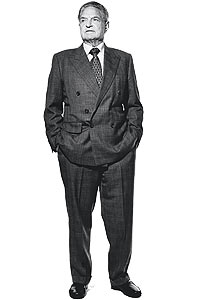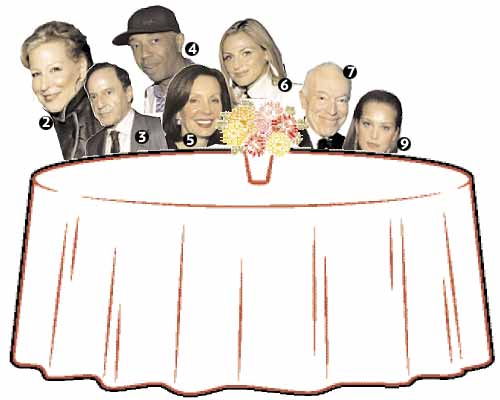
George Soros
Chairman, Soros Fund Management
The patron saint of emerging democracies. Over the past 30 years, Soros—who made his fortune in currency speculation and hedge funds—has done more to create “open societies” than many governments, giving away more than $4 billion to fight apartheid in South Africa, communism in Eastern Europe, and Republican rule in America. Okay, that didn’t exactly work out (as The Age of Fallibility, his forthcoming book, readily admits), but the $2.5 million he donated to MoveOn.org helped transform it from just another Web folly to a potent organizing tool.
Maurice “Hank” Greenberg
Chairman, the Starr Foundation
Though soiled by a fraud investigation, the embattled ex-chairman of the AIG insurance company is still the biggest fish in the philanthropic pond. Forced from his post by Eliot Spitzer’s phony-accounting probe, he remains in control of a foundation with assets of $3.5 billion and has given more than $1 billion to New York causes, from MoMA to New York–Presbyterian.
Paul Tudor Jones II
Founder, Robin Hood Foundation
He rewrote the rules of philanthropy by making nonprofits answer to their donors. Instead of giving money to financially unaccountable charities, the hedge-fund manager created the Robin Hood Foundation, which “invests” fully 100 percent of donors’ dollars in 230 anti-poverty groups that meet strict performance criteria and can demonstrate success (with help from Robin Hood’s consultants). His results-driven approach has attracted a celebrity- and Wall Street–heavy donor list that’s coughed up more than $400 million since 1988. A team led by David Saltzman actually distributes the money, making or breaking the ability of these groups to survive.
Hannah McFarland
Founder, the New York Public Library’s Young Lions
McFarland took as her unlikely mission that of transforming scenesters into philanthropists. In 1999, she wrangled Ethan Hawke to help turn the library into a center of literary life for New Yorkers in their twenties and thirties. Her Young Lions group now hosts an annual gala and fiction prize for writers under 35 (winners have included Jonathan Safran Foer and Colson Whitehead). In 2001, McFarland was hired as a consultant to Carnegie Hall; her reengineering of the institution’s young donors program—featuring “members-only” nights with Lou Reed and RZA—has boosted membership by nearly a third. This year’s project: Library Cubs, a series of readings for toddlers with deep-pocketed parents.
Vartan Gregorian
President, Carnegie Corporation of New York
He controls the purse strings of the Carnegie Corporation, which has funneled $55 million from an anonymous New York donor to hundreds of grassroots neighborhood groups over the past four years, like Coney Island’s Amethyst Women’s Project, which distributes condoms to prostitutes on the boardwalk, among other services. Unafraid to court controversy, Gregorian also threw Carnegie behind the Museum of Natural History’s Darwin exhibit when no corporation would sponsor it.
Evelyn Lauder
Founder, the Breast CancerResearch Foundation
Two words sum up Evelyn Lauder’s contribution to the field of philanthropy: pink ribbon. Through clever branding, the senior vice-president of Estée Lauder has spawned thousands of ribbon-festooned T-shirts, blow-dryers, and teddy bears, and an army of imitators like Lance Armstrong, with his yellow bracelets. Since 1992, when she amassed $18 million for a breast-cancer diagnostic and treatment center at Memorial Sloan-Kettering, she’s built her fund into a major sponsor of clinical drug research, raising $25 million last year alone. Spokeswomen like Liz Hurley—not coincidentally, an Estée Lauder pitchwoman—put a pretty face on her cause. Philanthropy: The Ultimate Charity-Gala Table
The Benefit Bunch
A charity-gala planner’s ultimate table.

(1.) Bruce Kovner
New York’s most unassuming philanthropist quietly donated $25 million to renovate Lincoln Center and recently slipped BAM $5 million.
(2.) Bette Midler
Has turned 60 city-owned lots into gardens, removed 80,000 tons of trash from parks, reclaimed more than 400 acres of riverfront parkland, and saved dozens of community gardens from bulldozers.
(3.) Mort Zuckerman
Raised $14 million in three days last year to buy Gaza Strip greenhouses for Palestinians, who subsequently looted them.
(4.) Russell Simmons
Wires $2 million a year from friends like Ludacris, Donald Trump, and Ron Perelman to 70-plus nonprofit arts groups, including galleries for black artists in Chelsea and Clinton Hill and, soon, an East New York megaspace.
(5.) Marie-Josée Kravis
The economist (a Hudson Institute board member) and her financier husband, Henry Kravis, have donated $25 million to Mount Sinai Medical Center and $10 million to the Metropolitan Museum of Art, among other gifts.
(6.) Laurie Tisch Sussman
After reading news stories about schools with no playing fields, she persuaded her father to build 43 athletic centers; her own fund has provided more than $30 million to arts groups.
(7.) Leonard Lauder
Persuaded his fellow Whitney Museum trustees to send $200 million on Pop Art and Abstract Expressionist works—then paid for most of it himself.
(8.) Richard Gilder
A founding trustee of the Central Park Conservancy, who donated a record $17 million in 1993. Still gives through his own $45 million–plus philanthropy fund.
(9.) Petra Nemcova
Tsunami-surviving, benefit-hopping model started a fundfor disaster victims, raising $1.3 million so far. At her auction at Cipriani’s, dinner with Nemcova and a few model pals (Sophie Dahl, Adriana Lima) went for $75,000.
(10.) Mercedes Bass
She and her oil-magnate husband, Sid, gave the Metropolitan Opera $25 million, the largest single unrestricted gift in its 123-year history. Next: The Influentials in Education